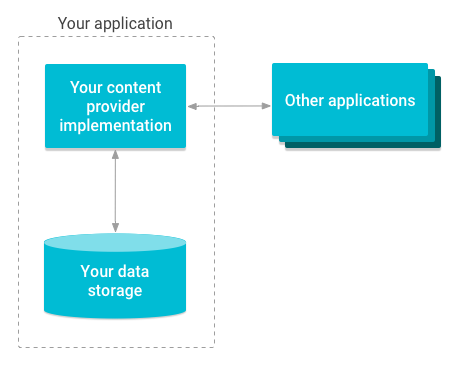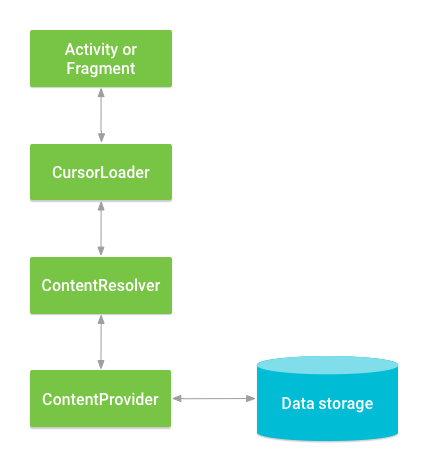When to use content provider:
- When we want to
share our data, files etc to other application then we can use content provider.
Following diagram illustrate basic of it.
- Let's consider
content provider app as server app and the app who use it called client app.
So to use server app's data, client app needs to use ContentResolver class to perform query to the server app. server app will return cursor to client app so client can iterate through it and read data from cursor. Following diagram illustrate it
-
Lets start server
side (ContentProvider related) Example.
Consider following package and files structure in server app already there so that we can only focus on content provider. It mainly having Database related files using Room library. Following is structure with use of each file- content_provider_demo (package)
- dao (package)
- RecentSearchDao : Dao class to perform query on recent search table
- ContentProviderDemoActivity: demo activity to get result from content provider and print in logs.
- Database: Singleton class to create RoomDatabase object if not exist
- Detail : contains static variables. i.e. Db name etc
- RecentSearch: Table of recent search, made using Room lib
- RecentSearchProvider: Our provider class. we will discuss about it in next section
- ScoscheDatabase: Room database config class contains all Dao and Entity.
- We are going to
provide access of our "Recent search" data to other app using "RecentSearchProvider" class. To do
that first we have to create "RecentSearchProvider" class as following. I have just use insert and
query method for demo purpose. you can use other methods like update, delete etc
How it works
:
- User can use this content provider using content resolver. in content resolver we need to pass
unique URI so that system can find which provider need to use and what table and data need to
access.
- We can construct Uri like following.
Uri = host://authority/table
Here, host is fixed string "content://".
authority is any unique string which we need to define. We can construct it like following.
- By URI passed in ContentResolver system can find our class and the method (query, insert etc) need to be call. Now user can do different select queries. For ex user can select all recent searches or user might need recent search for given id etc etc. so that we have created URI matcher here, So to get all recent search user need to use this content URI "content://$PROVIDER_NAME/$tblRecentSearch". To get recent search for ID = 4 user may use this type of provider "content://$PROVIDER_NAME/$tblRecentSearch/4".authority = package_name + "."+ your provider class name
-
We have to register this content provider class in AndroidMenifest.xml file to allow its access to apps. We can do it by adding following code in "application" tab.
Here, "name" contains path of our Content provider class and "authority" contains the authority of this provider.
- So server side (or ContentProvider related) logic done here.
- Client side (ContentResolver related) part start here.
Second part is "How to access data from ContentProvider".
We need to create ContentResolver object to access data from ContentProvider. Android have
getContentResolver() (contentResolver property for Kotlin) method to create object of
ContentResolver. ContentResolver have different methods like "insert","query","update",
"delete" etc to access data. We need to use ContentUri defined previously in content provider
to access its data. To insert data to recent search we can do like following.
- To get records from content provider we can use "query" method of contentResolver. It will return cursor
object so we can iterate through it to fetch data. Following example fetch all recent searches.
- That's it for contentResolver. Second part of code can be found in "ContentProviderDemoActivity".
Client side (ContentResolver related) ends here.
- You can find whole demo in Github. Github Link: https://github.com/k9428/Content-Provider-Demo
thank You very Much:)) I was looking for just like this, real kotlin solution for content provider:) thanks!!
ReplyDelete